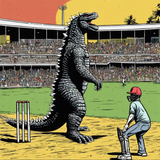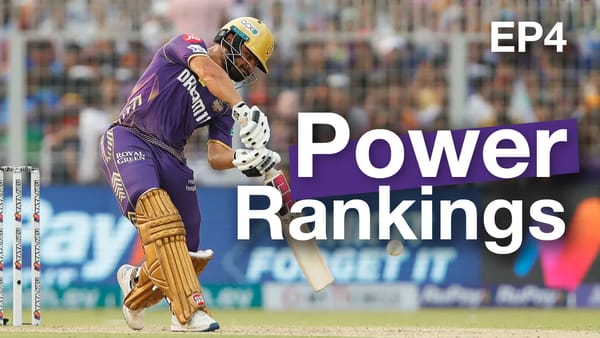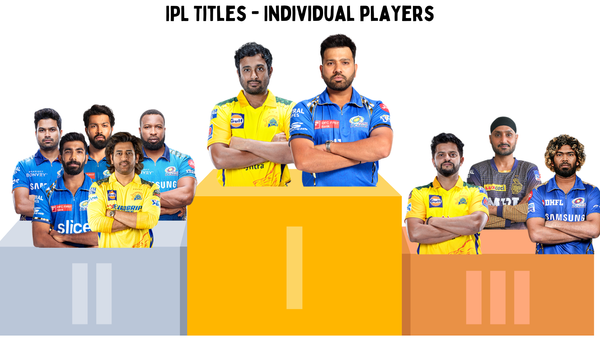The short story of long IPL innings
A long innings in short cricket has a lot of journey
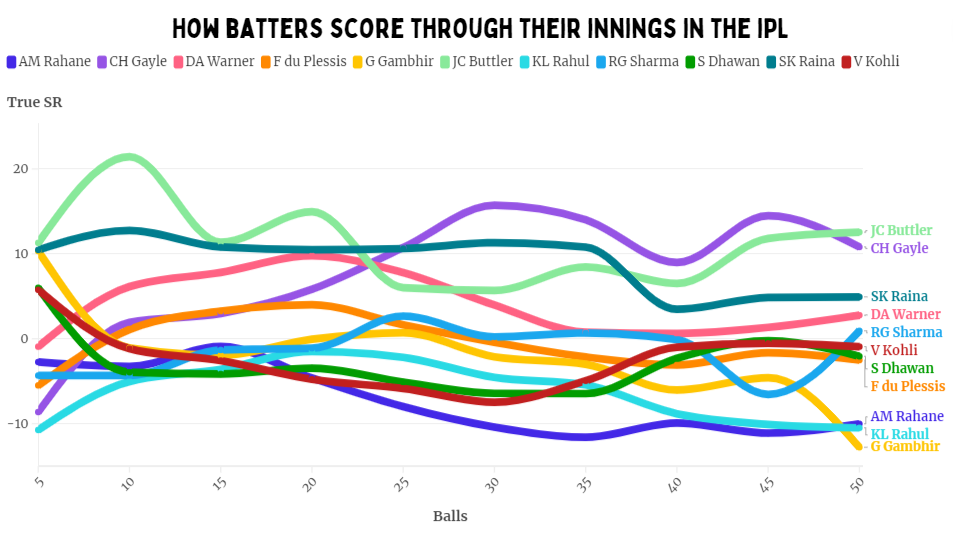
This post is brought to you by Cricket8. We’ll be writing there throughout the IPL. Plus there are podcasts and live watchalongs.
Stats by Varun Alvakonda
The longest innings ever played in the IPL is still the first one by Brendon McCullum, but Virat Kohli faced one less delivery in his knock against Rajasthan Royals on April 6. There have been 439 innings of more than 50 balls in total.
Only 11 players have done it 10 times. Of those, KL Rahul has the most, with Kohli and Shikhar Dhawan not far behind. You can see this group of players has been involved in many of the longest innings ever. So that allows them to show us how different players build long T20 knocks.
If we look at raw strike rates, we see a pattern similar to how a T20 innings progresses. Players start slow, have a little bit of a pause after the powerplay, and then score fast at the end. The most interesting thing about this is that not a single one of these players is what we’d classify as a fast starter. Jos Buttler has the quickest strike rate after five balls, and it’s only 112. To bat long a lot, you need to build a base. That should not be surprising to anyone.
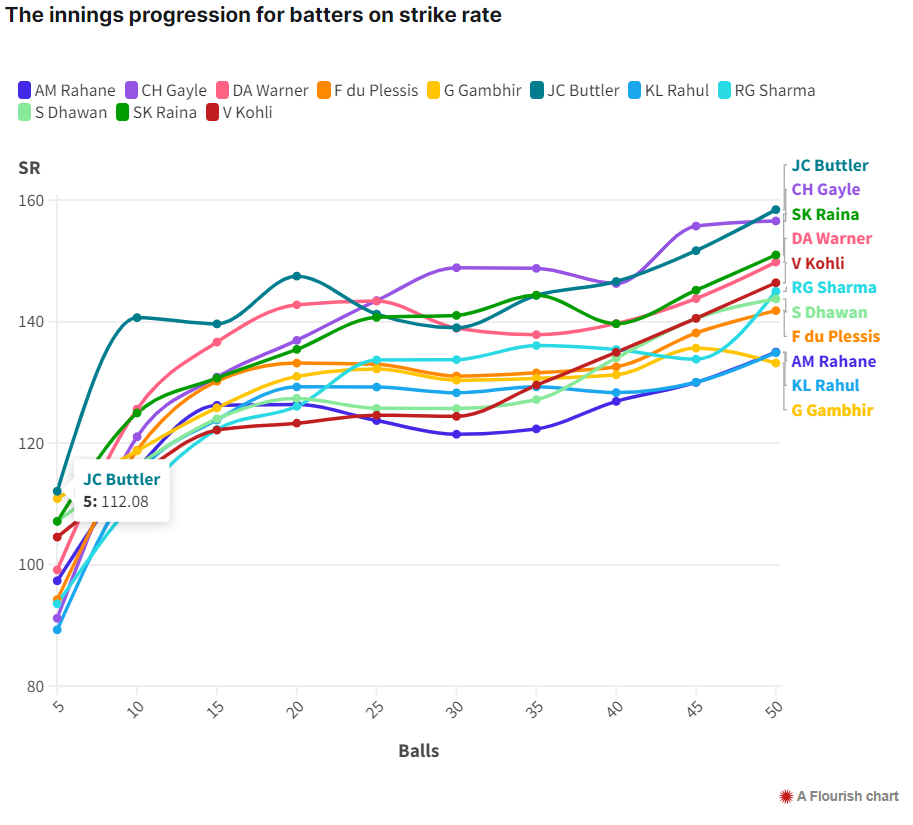
But not all of these players were in for the powerplay, and a few don’t always make it to the end. We need something much better than the raw numbers. So we are using true strike rate here, which is comparing a player’s mark on each ball to that of what everyone else scores from the same deliveries.
This is their strike rate at the first five-ball mark and for five-ball intervals afterwards. I know this is a mess, but once you start to look at it long enough, you realize the art within.
With Rohit Sharma, here you see a player who has batted right across all five spots in T20 and has the shambolic line to prove it. But within this, you have when he scores quicker or slower.
0 is neutral, and you can see that for the first 20 balls, he is below that. Then he does kick up a little and starts to really score. Before this weird dip at the end and then starts to smash it again. The Rohit we have this year is totally different, but we have seen many versions of him, so that is why his map probably makes the least sense.
Let’s look at the three best overseas openers. You can see the neutral line is well down, because these are all players who score above zero on true strike rate for all their innings.
But, not quite. Obviously Chris Gayle is a slow starter. He is the second slowest on this list with a strike rate of 91 for his first five balls. On true strike rate, we have him listed as -9. From there on in he rises pretty rapidly until he leads this group comfortably, scoring at plus 15 at his highest.
You can see that Buttler is way different. He is a really fast starter – touching levels Gayle doesn’t – and then slows down. These are incredibly different methods, and it isn’t until the 25-ball mark that Gayle is scoring quicker than him. So for short innings, Buttler is giving you great value, and Gayle is giving you nothing. But they’re both killers if they stick around.
Warner is very different again. He starts neutral and enjoys the powerplay, but as his innings go on, he slows down on true strike rate. He is always scoring faster than the game, but he can’t go nuts at the end like these other two can.
What about if we look at the Indian openers? You can see just how much slower they are than the big-name overseas players. However, that is not the interesting thing here.
Kohli and Dhawan are almost identical. They start faster than normal players, instantly slow down into the next five, and never return with a positive true strike rate. But then they follow the exact same pattern of knocking the ball around and finally giving you close-to-par hitting at the end.
You will see there is not a part in the game where KL Rahul is scoring quicker than expected. He doesn’t get their start, but he actually scores quicker in the middle before slowing down from the 30-ball mark.
We hear a lot about catch-up innings, but in terms of pure efficiency, none of them have it. But Rahul is certainly the player who is the worst on true strike rate. And if you are thinking, well, sometimes his strike rate is good at the end of the season. It is because he bats longer into the game, where the rates go up naturally anyway. So he might still be striking at 150 or 160 here; it is just that the rest of the league is at 170.
What if we look at a middle-order legend instead, Suresh Raina? The advanced numbers love him. He starts fast and keeps that level for the first 35 balls but then drops off at the end. At first, I thought he might get tired—and that is a possibility. However, it’s probably due to the fact that he came in to face spin, was great against it, and then, in the end, slowed down when the quicks came back on.
Here is the peanuts and bubblegum part. Two players no one ever wants to put together: Gautam Gambhir and Faf du Plessis. The two openers are stylistically very different, but their pattern is similar. You can see Gambhir is another one of these Indian openers who scores fast for five balls, whereas Faf doesn’t. But from then on, this is a similar pattern.
Checking their records, Gambhir scored quicker against spin than pace (which is very rare), while du Plessis is one and a half runs quicker versus pace than spin. So they got these similar shapes in very different ways. Both played on home wickets with lots of turn and spin in the powerplay. So I’m a bit stumped.
But they are not identical. Du Plessis will score quicker in the powerplay, and while his scoring dips off to under par from the 30th ball onwards, he is close to neutral. Where Gambhir couldn’t hit boundaries at all with a softer ball when he was long into his innings.
The player with the worst record on here is Ajinkya Rahane. And that is not surprising because outside of about three plus years in the IPL, he has been terrible. But you can see he holds up near neutral in the first 15 balls, and then you really want him out – if you’re on his team. It might have been why last season he started slogging out the gates, maybe he was told just to face 15 balls and get out. But it is also possible he’s trying to maximize his scoring from pace, because he’s so slow with the turning ball. Which is why this has traditionally dropped off so much.
But what if we add back Rahul here? We see that he clearly plays the spinners a lot better but isn’t really capitalizing on the field being up at all. But the really sad thing is he ends up around that Rahane mark from the 40th ball, which is really poor. Also, both of these players never have a period when they strike quicker than average. They are both consistently negative on true strike rate.
But let us finish with this, Kohli and Gayle. I love this because these two actually played together, and they are near mirror images of each other. Kohli played a few shots to start with, then accumulated forever. Chris Gayle gets set and quickly goes boom. These are probably the two most famous long innings batters in T20 cricket, and they could not be any more different than each other.
A long innings in short cricket has a lot of journey.
